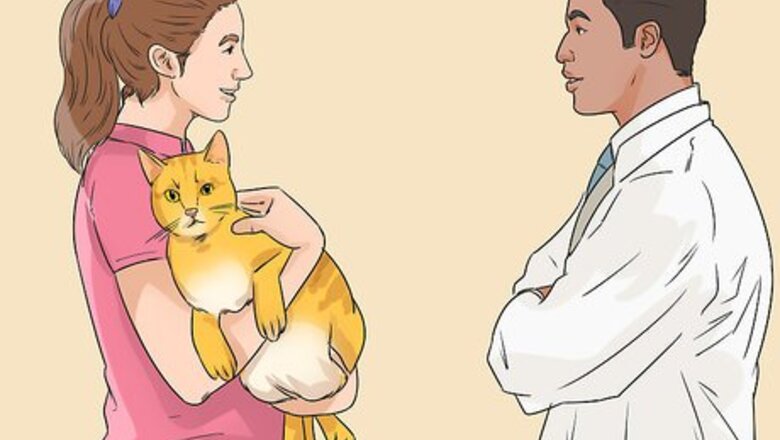
views
X
Research source
Overall, physical therapy can help your cat get movement and flexibility restored more quickly and completely. The key is to identify problems that could be helped by physical therapy and to complete a physical therapy regime under the guidance of a veterinarian.
Completing Physical Therapy
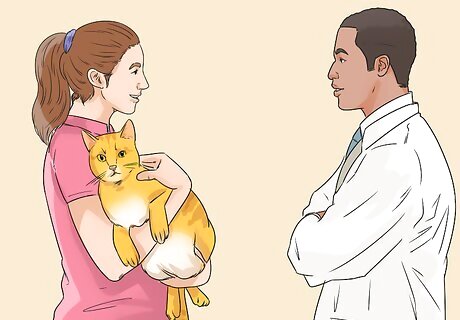
Consult with a physical therapist. Take your cat in to see a veterinary physical therapist. The therapist will look at the cat's veterinary history and assess their health. Once they have all of the information, the therapist will decide what, if any, type of physical therapy will help your cat the most. In most cases, you will be referred to a veterinary physical therapist by your primary care veterinarian.
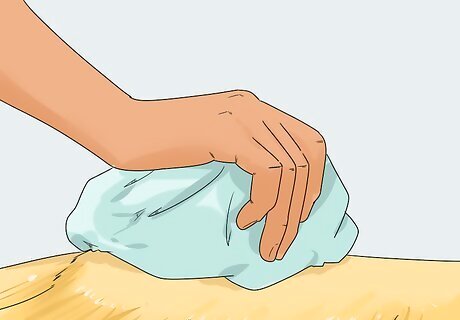
Apply hot and cold treatments. One of the most effective and easiest types of physical therapy that can be used on cats are hot or cold treatments. By applying heat or cold to an injury, pain and swelling can be relieved. Your veterinary physical therapist will tell you whether to apply heat or cold to the injury. This is usually dependent on whether there is swelling on the injury. In most cases, cold will be applied to injuries that are swollen. When applying a cold treatment, use a thin towel as a barrier between your cat and the ice or cold compress. Putting ice directly on your pet’s skin or fur could cause cold burns. Typically, heat or cold are applied for only about 20 minutes several times a day. A hot water bottle can be great for applying either heat to an injury.
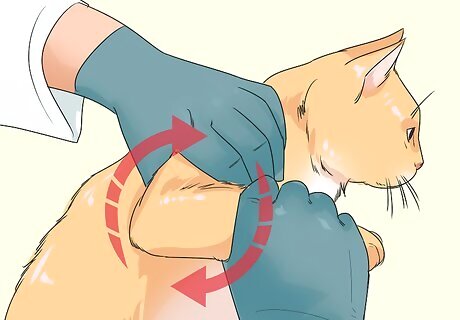
Complete passive rehabilitation. Your physical therapist may suggest specific types of movement that will help your cat to heal and get full range of movement back. If your cat hasn't moved recently, your therapist might suggest passive rehabilitation. With passive rehabilitation, the joints will be manually moved without pressure placed on them. This type of rehabilitation improves the function of your cats joints and it can increase their muscle mass. It can be helpful to have another person hold your cat still while you move their limbs through the range of motion poses.
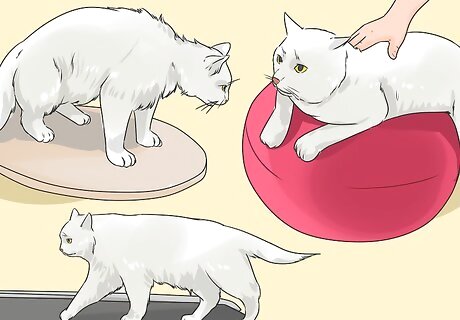
Have active rehabilitation done. If your cat has had an injury or disability and is having difficulty walking, then your animal physical therapist may suggest active rehabilitation. With active rehabilitation, the therapist will help your cat to regain their ability to move on their own using a variety of exercises that use the cat's own body weight. Exercises that are considered active rehabilitation include: Ball exercises Balance boards Treadmills Tread-pools or swimming
Using Alternative Treatments
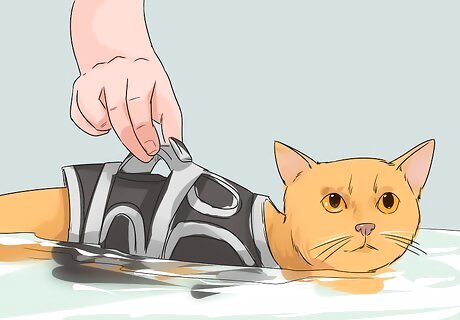
Consider hydrotherapy. While it is common knowledge that most cats do not want any contact with water, hydrotherapy can be used on them to increase their mobility. Hydrotherapy on cats usually entails the cat walking on a treadmill that is submerged a few inches underwater. This allows the cat to begin walking on an injured leg or hip more easily. There is some debate about whether hydrotherapy causes too much stress for cats. If your cat is extremely resistant to getting wet, then they may have a hard time adjusting to this type of therapy. Speak with your veterinarian to determine if your cat is a good candidate for hydrotherapy.
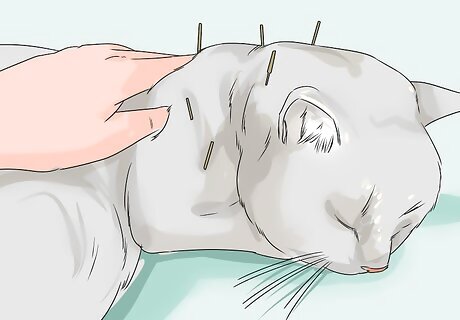
Have your cat undergo acupuncture. Acupuncture can be a great treatment option for cats with mobility issues or for those that are recovering from trauma. Acupuncture invigorates the immune system by stimulating areas of the body that contain lots of vessels and nerves, which can help to speed up recovery and to minimize pain and discomfort. This process requires very specific knowledge about acupuncture points on animals. Thus, it should only be done by a licensed animal acupuncturist. You may be able to get a referral to a licensed animal acupuncturist through your veterinarian if they know of one in your area. If not, find a licensed animal acupuncturist by searching the websites of animal acupuncture professional associations, such as the American Academy of Veterinary Acupuncture.
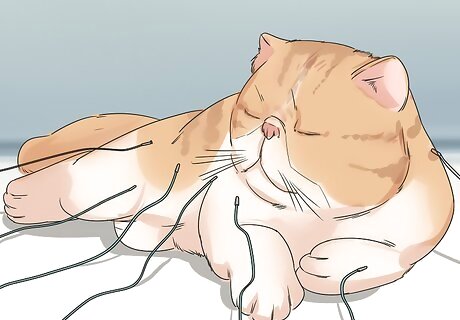
Discuss the option of electrotherapy. Talk to your veterinarian about whether neuromuscular electrical stimulation might help your cat. The use of electrotherapy can help with pain management and muscle movement, as the electrical pulses used increase movement by contracting muscles and they also stimulate cell activity that can minimize pain. There are three types of electrical stimulation used on cats. One type, transcutaneous electrical nerve stimulation, is used to manage pain. Another type, neuromuscular electrical stimulation, is useful only for muscle rehabilitation. The last type, pulsed electromagnetic field therapy, can help with both pain and muscle rehabilitation.
Assessing the Need for Physical Therapy
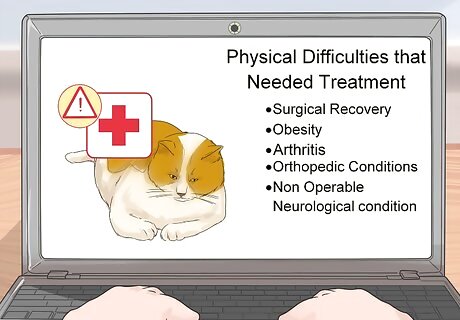
Identify any physical difficulties that need treatment. There are a wide variety of injuries and disabilities that can be helped with physical therapy. If your cat has an old existing injury or a physical disability that they were born with, consider getting them treatment so that any pain or discomfort they have can be minimized. Some conditions that may be helped with physical therapy include: Surgical recovery Obesity Arthritis Orthopedic conditions (including medial patella luxation, early partial cranial cruciate ligament rupture, hip dysplasia, elbow dysplasia) Non-operable neurological conditions (such as fibrocartilaginous embolism) Amputation recovery Non-healing wounds Muscle wasting (due to Cushing's disease or chemotherapy for example) Limited movement due to old age

Discuss treatment options with a veterinarian. Your veterinarian may have a variety of suggestions for treatment of an injury or illness. Among these may be physical therapy, as it can help speed recovery and eliminate pain and discomfort. Ask your veterinarian about the specific type of therapy they would suggest and ask any questions you have about your cat's potential for recovery. In most cases, your regular veterinarian will not be able to do intensive physical therapy on your cat. However, they may be able to suggest some simple things you can do to minimize your cat's discomfort, such as applying ice or heat to an injury.
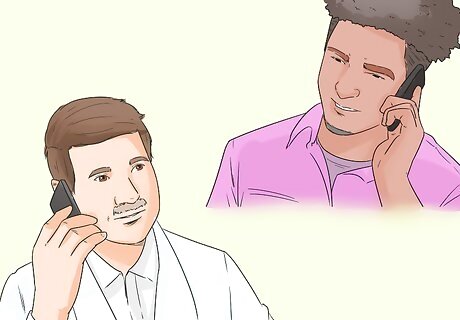
Contact a physical therapist. Your veterinarian should give you a referral to a qualified physical therapist that works on cats. Make an appointment and then bring your cat in for their appointment. If there is not a veterinary physical therapist in your area, you may need to travel to get your cat this kind of care. If you have not gotten a referral, do an online search for veterinary physical therapists in your area. Make sure that those that you consider have a veterinary medicine degree from an accredited institution and that they have experience treating cats. Avoid doing physical therapy on your cat by yourself. You could worsen the injury or condition if you don’t have the proper knowledge of feline anatomy.


















Comments
0 comment